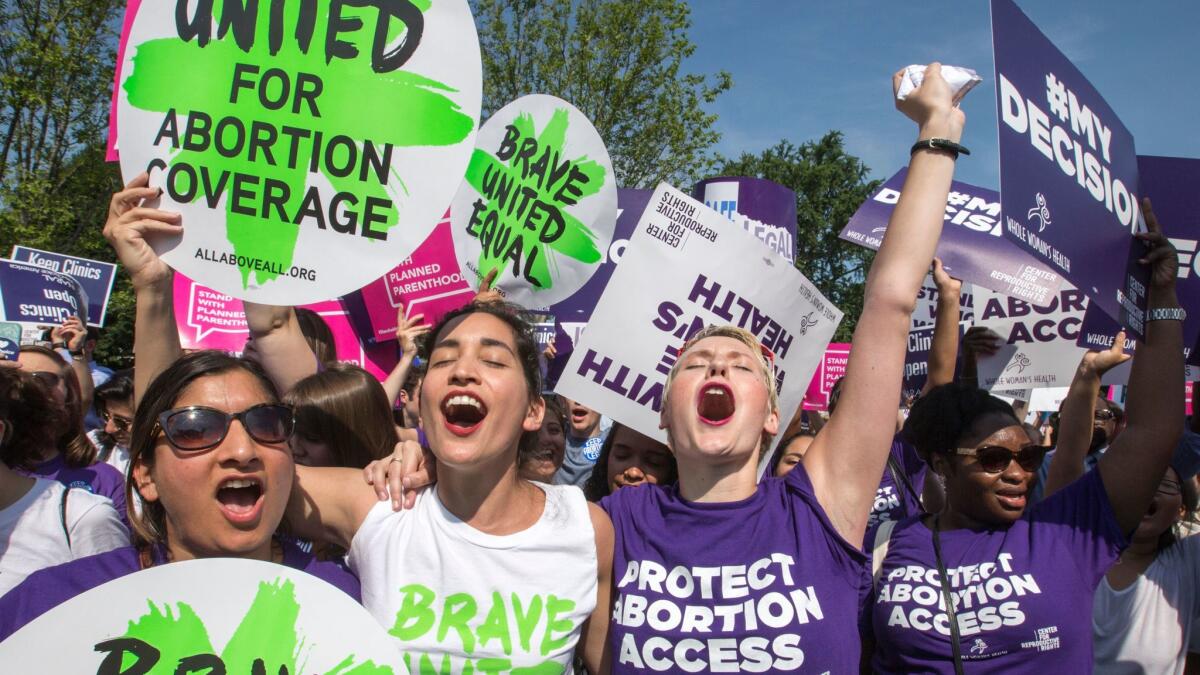U.S. abortion rate drops to a new low, but there’s a fight over why

The U.S. abortion rate has hit its lowest point since the landmark Roe vs. Wade Supreme Court ruling made the procedure legal nationwide in 1973, according to a new study.
Researchers at the Guttmacher Institute, a New York-based think tank that supports legalized abortion, estimated that there were 926,200 abortions in 2014, or 14.6 for every 1,000 women of reproductive age. That was down from a peak of just over 29 out of every 1,000 women in 1980 and 1981.
The institute is considered an authority on the abortion rate, having tracked it since 1973 by conducting a census every few years of all known abortion providers. Its counts do not include abortions done outside medical settings.
Activists on both sides of the contentious abortion policy debate welcomed the findings but did not agree on what is causing the decline.
Since 1982, abortion rates have dropped steadily, even as public opinion about the procedure has remained relatively consistent. In 2016, 57% of those surveyed by the Pew Research Foundation said that abortion should be legal in all or most cases.
What do abortion defenders say?
Reproductive rights advocates say the study shows that increased access to family planning services and contraception is paying off, reducing the number of unintended and teen pregnancies.
“We don’t think it’s because people are having less sex,” said Dr. Diane Horvath-Cosper, an obstetrician with the New York-based group Physicians for Reproductive Health. “It’s because people are protecting from pregnancy better than they used to.”
Research has shown a large increase in the use of intrauterine devices and implants that release hormones — highly effective, long-acting methods that in recent years have become more affordable and been deemed safe for use in adolescent women.
Under the 2010 Affordable Care Act, which President Trump and the Republican leadership in Congress have vowed to eliminate and replace, insurers are required to cover a wide variety of contraception methods without charging a copayment or coinsurance. Doctors say that requirement has helped their patients access new methods of contraception or stay on birth control without missing doses.
“Women and families are healthier, and people are better able to plan their lives, their families, and their futures,” said Amy Rosenfeld, a spokeswoman for Planned Parenthood Los Angeles, in a statement. “This report underscores that we need more access to birth control and preventive care, not less.”
What do abortion foes say?
Some abortion opponents express reservations about the report’s findings because they are based on information provided by physicians who offer abortions.
“There is no national abortion reporting law, making it impossible to know the true number of abortions,” said Kristi Hamrick, a spokeswoman for Americans United for Life.
The group hopes that there has indeed been a decline in the number of abortions in the U.S. but disputes the reasons offered by abortion rights activists.
“The abortion industry wants to claim that the abortion rate may be lower because of another product that they sell — birth control. But birth control is widely available and has been around since the 1950s,” Hamrick said in an email.
She pointed instead to a wave of state laws passed over the last five years that imposed increasingly stringent regulations on abortion providers and their patients, including a requirement that women have an ultrasound before undergoing the procedure.
“Such pictures are worth more than a thousand words when it comes to helping people understand whose lives are on the line,” said the group’s acting president, Clarke Forsythe, in a statement.
What do the study’s authors say?
The study did not investigate the causes of the decline, but researchers said both greater use of contraception and increased restrictions on abortions may have played a role.
From 2011 through 2015, Guttmacher recorded 288 laws passed in 31 states that limited abortion access for minors, required counseling or a waiting period, imposed regulations on providers or targeted funding for family-planning services, among other restrictive measures.
“Abortion restrictions and clinic closures mean that patients may need to travel greater distances to access services,” said Rachel Jones, lead author of the study. “The majority of abortion patients — 75% — are poor or low-income, and nearly two-thirds are already parents. It can be very difficult for them to arrange for time off from work, transportation and child care.”
Dr. Daniel Grossman, an obstetrician at UC San Francisco who has studied the effect of abortion laws in Texas, doubts that the decline in abortions in that state has much to do with changes in contraception use.
In 2013, the Texas Legislature passed House Bill 2, which made it harder for patients to receive abortion-inducing medications, required abortion providers to have admitting privileges at a local hospital, banned abortions after 20 weeks of pregnancy and required all abortions to take place in hospital-like settings known as ambulatory surgical centers. Almost overnight, more than half of the state’s 41 clinics closed.
Grossman and his colleagues at the Texas Policy Evaluation Project found that, while the total number of abortions in the state dropped after the law took effect, the number performed during the second trimester rose. That suggested to the researchers that women were struggling to find abortion providers, resulting in delays and procedures that are riskier and more expensive.
A colleague of Grossman at UCSF, Diana Greene Foster, says there is “zero evidence” that laws aimed at changing women’s minds — those requiring ultrasounds, waiting periods or counseling, for example — are affecting abortion rates. “But clinic closures and gestational limits — those certainly have an effect on women with limited resources,” she said.
By 2014, 90% of all U.S. counties — accounting for 39% of women of reproductive age — had no clinic that provided abortions, the study found.
But the majority of the decline in abortions occurred in states that did not have major new restrictions in place. Six states saw increases in the abortion rates: Arkansas, Kansas, Michigan, Mississippi, North Carolina and Vermont.
Foster and other experts credited the Affordable Care Act with making contraception more affordable and convenient. They worry that the abortion rate could rise if Congress, in its effort to repeal the law, does not preserve mandated insurance coverage for birth control.
To read the article in Spanish, click here
Times staff writer Alexandra Zavis contributed to this report.
Twitter: @AgrawalNina
ALSO
Judge blocks Texas from cutting off Planned Parenthood funds
ACLU challenges Kentucky’s new ultrasound abortion law
More to Read
Sign up for Essential California
The most important California stories and recommendations in your inbox every morning.
You may occasionally receive promotional content from the Los Angeles Times.











